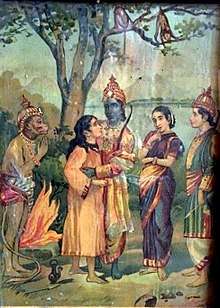Bharata (Ramayana)
Bharata is a Hindu deity depicted in the Indian epic Ramayana. Bharata was the younger half brother of Rama. Ramayana holds Bharata as a symbol of dharma and idealism.
| Bharata | |
|---|---|
 Bharata asks for Rama's paduka (footwear) | |
| Devanagari | भरत |
| Sanskrit transliteration | Bharata |
| Affiliation | Avatar of Panchajanya Shankh |
| Texts | Ramayana and its other versions |
| Personal information | |
| Parents | Dasharatha (father) Kaikeyi (mother) Kaushalya (step-mother) Sumitra (step-mother) |
| Siblings | Rama (step-brother) Lakshmana (step-brother) Shatrughna (step-brother) Shanta (step-sister) |
| Spouse | Mandavi |
| Children | Taksha Pushkala[1] |
| Dynasty | Raghuvanshi--Suryavansha |
According to the Ramayana, Rama is the seventh avatar of Vishnu while Lakshmana, Bharata and Shatrughna are considered as part-incarnations of Sheshanaga, Shankha and Sudarshan Chakra respectively.[2]
One of the only temples in India dedicated to him is the Sangharatna Temple in Kerala.
Etymology
Bharatá is a Vedic Sanskrit word. Monier Monier-Williams states that it means "to be or being maintained."[3]
Birth and marriage
Bharata was born to the virtuous king of Ayodhya, Dasharatha and his second wife, Queen Kaikeyi. He was married to Mandavi, daughter of Kushadhwaja, Janaka's younger brother. Thus, Mandavi was Sita's cousin. They had two sons - Taksha and Pushkala.[4]


Description
According to Valmiki Ramayana[5] the four sons of king Dasharatha i.e. Rama, Lakshmana, Bharata and Shatrughna were very close to each other. Ram was in line to become the king of Ayodhya, as dictated by Primogeniture policy followed in the Ikshvaku clan, which they belonged to. But, Bharat's mother Kaikeyi, before the crowning of Rama went into Kopa Bhawan. The Kopa Bhawan was a place where the wives of the ruling king could go when they felt neglected, in order to compel the king to come visit her and hear her complaints. When king Dasharatha arrived, she reminded him of the two wishes he had offered to her when she had saved his life in a battle. For her first boon, she asked for the exile or Vanvas of Rama for 14 years. Her second wish was to make her son Bharata, the second in line to throne, the heir apparent. Since the clan of Raghu ( as the Ikshavaku clan is also called ) was known for keeping their word, Dasharatha had no choice but to adhere to her wishes. Once the order was officially announced, Rama went to exile with his wife Sita and younger brother Lakshmana. Bharata was visiting his maternal relatives, and on returning a few days later, heard the news of his elder brother's exile and his crowning as the heir apparent. Due to the bond shared between the brothers, he became angry with his mother Kaikeyi and her maid Manthara, who had sown the seeds of discord in Kaikeyi's mind. As King Dasharatha lay on his death bed, he cried for his eldest son Rama. On his death, Bharata along with the mothers and Shatrughan went to meet Rama and requested him to come back. When Rama refused to dishonor his father's word, Bharata asked for his sandals. He then placed the footwear on the royal seat of Ayodhya, thus laying clear the fact that Ram was the de facto ruler of Ayodha, and Bharata would only rule in his stead, for the time he wasn't there. In the 14 years that followed, he went to Nandigrama (forest near Ayodhya) to pray to gods for his brother's safe arrival, living in austere conditions and leaving the amenities of the royal palace. There, he survived by eating only kanda mul and wearing the rough clothes of rishi munis or hermits. After 14 years, Rama was reunited with him and they went back to Ayodhya. There, Rama was crowned the king.
In popular culture
| Year | TV Series | Channel | Country | Played by |
|---|---|---|---|---|
| 1987–1988 | Ramayan (TV series) | DD National | India | Sanjay Jog |
| 1997-2000 | Jai Hanuman (1997 TV series) | DD Metro | India |
Riten Mukherjee |
| 2000 | Vishnu Puran | Zee TV | India | Ayush Pandey |
| 2002 | Ramayan (2002 TV series) | Zee TV | India | Ayush Pandey |
| 2008–2009 | Ramayan (2008 TV series) | NDTV Imagine | India | Vijay Bhatia |
| 2012–2013 | Ramayan (2012 TV series) | Zee TV | India | Nishant Kumar |
| 2015–2016 | Siya Ke Ram | Star Plus | India | Sujay Reu |
| 2019–2020 | Ram Siya Ke Luv Kush | Colors TV | India |
There are many folk songs dedicated to Bharata in Indian languages, mostly in Malayalam.
See also
- Genealogy of Rama
References
- Ramayana – Conclusion, translated by Romesh C. Dutt (1899)
- Naidu, S. Shankar Raju; Kampar, Tulasīdāsa (1971). A comparative study of Kamba Ramayanam and Tulasi Ramayan. Shank. University of Madras. pp. 44, 148. Retrieved 21 December 2009.
- Monier Monier-Williams, भरत, Sanskrit English Dictionary with Etymology, Oxford University Press, page 747
- Ramayana – Conclusion, translated by Romesh C. Dutt (1899)
- Valmiki (1963). The Ramayan. Sanskrit Series Office. OCLC 969728693.
- Ramayana, translated in English by Griffith, from Project Gutenberg
- Poddar, Hanuman Prasad (2001), Balkand, 94 (in Awadhi and Hindi), Gorakhpur: Gita Press, ISBN 81-293-0406-6, archived from the original on 13 July 2010
- Bhalla, Prem P. (1 January 2009), The Story Of Sri Ram, Peacock Books, ISBN 978-81-248-0191-8
External links
| Wikimedia Commons has media related to Bharata (Ramayana). |
.jpg)
